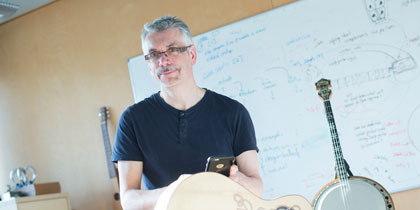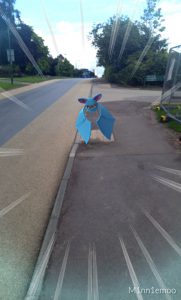
July 15, 2016, by Lindsay Brooke
Is Pokemon Go just the beginning?
I’m both excited and intrigued by this week’s hullaballoo around Pokémon Go.
These are the words of Steve Benford, Professor of Computer Science & EPSRC Dream Fellow and Professor of Collaborative Computing in the Mixed Reality Laboratory in the School of Computer Science at The University of Nottingham.
So what’s his take on the latest Pokémon craze? He thinks we are in for an interesting ride. Read on.
Having worked on the technologies of locative/pervasive/mixed-reality (choose your name to suit or make up your own if you’d prefer) games for many years, it’s exciting to see this break-through commercial example getting some serious play and airtime. Perhaps this really could become a major new game genre?
As someone who has also studied such games, it’s not so surprising to see people getting hot and bothered about how they impact on the public spaces in which they are played. It is a defining feature of the genre that they ‘unchain players from the console’, leading them out into the everyday-world that then becomes the backdrop for the gaming experience. Inevitably there will be consequences.
What is more intriguing is that recent stories appear to adopt contradictory stances. Let’s take a couple of examples from that crustiest of news outlets, the Today Programme on Radio 4, always something of a bellwether as to how the somewhat bemused non-gamer world is reacting to the latest developments in games technologies.
First up on Tuesday was a fairly upbeat piece that took the general line that San Francisco gamers are leaving their bedrooms and emerging blinking into the sunlight to meet up on the beach near the Golden Gate Bridge – and hey, guess what? – this ‘being outdoors’ thing is pretty cool. The implication here is that this new kind of gaming will be good for players, getting them outdoors and even socializing. This taps into some of widespread criticisms of conventional games – claims about a sedentary and obese generation of players, and also claims in the research literature that mobile games might even make people fitter.
 But hold on, next up on Wednesday is the story that the US Holocaust Museum has requested Pokemon Go players to desist from playing at their site out of respect. Having groups of people wandering around a holocaust museum catching Pokemon now feels like a bad idea, something that disrupts the everyday world in a bad way.
But hold on, next up on Wednesday is the story that the US Holocaust Museum has requested Pokemon Go players to desist from playing at their site out of respect. Having groups of people wandering around a holocaust museum catching Pokemon now feels like a bad idea, something that disrupts the everyday world in a bad way.
So which is it – good or bad? As ever, it’s complex. The defining feature – perhaps the whole point – of these kinds of games is that they trade on setting up some kind of relationship between the ‘real’ world of the everyday and the ‘virtual’ or narrative word of the game. This relationship might then configured in various ways. The relationship might be harmonious – hanging around on a beach at sunset catching some Pokemon with your new friends – or juxtaposed or even conflicted – playing a frivolous game on your phone in a setting that commands deep respect. Either way, the point is that the game designers, distributors and also the players need to think about it carefully. The relationship between the real and virtual worlds is both a new design opportunity and a new challenge.
To see how interesting and complex this can become, let’s look back at the work of some ‘masters’ in the field, the UK artist group Blast Theory who have been winning awards for making artistic games that mix real and virtual since the early noughties. Blast Theory’s works reveal a deep understanding of how to combine real and virtual. Take their piece Uncle Roy all Around You from 2003 (co-developed with our Mixed Reality Lab at Nottingham) that send mobile ‘street’ players on a journey through central London, following a series of location-triggered clues as they searched for the mysterious ‘Uncle Roy’, eventually being led to enter a deserted office, phone box and finally a waiting limousine. At the same time, online players logged in over the Internet explored a parallel virtual city, discovering the location of Roy’s office and them communicating with the far-away ‘street’ players. Here’s video of Uncle Roy.
The key to this game was its ambiguous framing, blurring the boundary between fiction and reality, with the clues being carefully deigned to cast doubt in players’ minds as to exactly what was fictional and what was real. Is that person in the white tee-shirt part of the game or just a passer by? Should they ask a cabbie for directions? Should they go into that office and fill in a postcard? And of course, ultimately, should they get into that limousine?
These questions reveal opportunities for creating powerful new cultural experiences – generating a frission of excitement or causing players to reflect and re-imagine the world around them. At the same time, they introduce risk, both to the players themselves and potentially to unwitting bystanders and other users of the places in which they are set.
And this is only one of only many ethical challenges that are raised by such games. What about notions of consent and withdrawal, or privacy, trust and safety? All of which have led us to publish a first attempt to confront the ethical challenges of cultural experiences that mix real and virtual worlds.
So Pokemon Go is probably just the beginning. It’s a relatively simple and friendly game – in concept anyway – that is driving interest and already creating debate. How will we cope with darker and more challenging games? Location based Grand Theft Auto anyone? Or thousands of people descending on Whitehall to hunt down spies? Or what if such a game involves kidnapping people (oh – that one’s actually been done at least a couple of times already)?
We’re in for an interesting ride. Time to dust off and re-read some of those academic studies from a decade ago perhaps?
Written by Professor Steve Benford.
No comments yet, fill out a comment to be the first


Leave a Reply